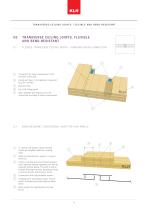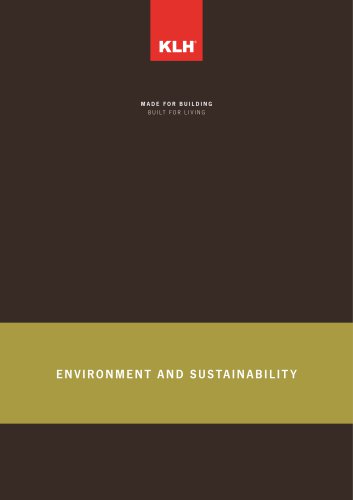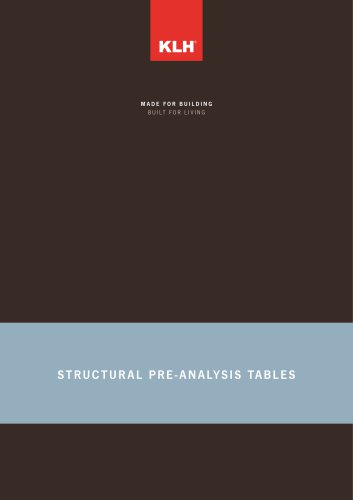
Catalog excerpts

IMPRINT © KLH Massivholz GmbH Publisher and responsible for the content: KLH Massivholz GmbH Version: 01/2011, Component Catalogue for Cross laminated timber Structures The content of this brochure is intellectual property of the company and is protected by copyright. The statements are recommendations and proposals only; a liability on the part of the publisher is excluded. Any type of reproduction is strictly forbidden and only permitted after written approval of the publisher.
Open the catalog to page 2
The suggested constructional designs with KLH solid wood panels show application details in a systematic and self-explanatory form. cellulose, etc. as well as different façade materials on back-ventilated façades or rendered façades. The structural and physical aspects such as sound insulation, heat insulation, air tightness of the building or fire protection must be assessed on the basis of the relevant project. Users and planners will be able to easily derive projectspecific details with reference to the basic depictions. The suggested detailed solutions merely represent recommendations...
Open the catalog to page 4
Architect Dipl. Ing. Huber t Rieß,
Open the catalog to page 5
WALL- CONCRETE CONNECTION WALL- CONCRETE CONNECTION WITHOUT ADDITIONAL SILL PLATE KLH wall panel according to static requirements E.g. BMF angle bracket Shear transmission and tension anchorage for the walls according to static requirements The walls must rest on the base over their entire length – if the walls only rest on the base in some places, static verification is required Caution: At least 2 dowels must be installed for each BMF angle bracket; otherwise the effect of the angle bracket is highly reduced (preferably use the two holes directly next to the wall or the sill plate)...
Open the catalog to page 6
WALL- CONCRETE CONNECTION WITH HIGH SILL PLATE KLH wall panel according to static requirements E.g. BMF perforated plate for shear connection between KLH wall and sill Concrete component (wall, ceiling, concrete slab) Concrete screws for shear force transmission between sill and concrete Oak or larch sill laid in mortar bed – with the entire surface resting on the base Install joint tape, if necessary Diagonal fully threaded screws to absorb higher horizontal forces Sill plate laid in mortar bed and dowelled to concrete CONNECTION OF THICKER EXTERIOR WALLS 2 x sealing tape along...
Open the catalog to page 7
WALL-WALL CONNECTION, CEILING -WALL CONNECTION WALL-WALL CONNECTION, CEILING-WALL CONNECTION 2.1 EXTERIOR WALL – INTERIOR WALL - CEILING Cross wall connection – screw connection from the outside Cross wall connection – screw connection from the inside Shear force transmission along the joint and tension anchorage of walls – e.g. BMF angle bracket – type, distance according to static requirements Screw connection of ceiling with walls according to static requirements 2.2 EXTERIOR WALL – EXTERIOR WALL - CEILING Corner joint – screw connection of wall corners according to static requirements...
Open the catalog to page 8
WALL-WALL CONNECTION, ROOF-WALL CONNECTION WALL-WALL CONNECTION, ROOF-WALL CONNECTION CONNECTIONS OF WALLS AT AN ANGLE TOWARDS EACH OTHER For very shallow angles, the effectiveness of screw connections is quite limited; special measures might become necessary The screws only transfer shear forces in the direction of the joints; mind the reduced bedding lengths Bevelled panel edges can only be easily produced up to approx. 20 cm of bevelled length Required edge distances for the screws Shiplap design if high shear forces must be transferred 3.2 EAVES DESIGN WITH CANOPY OR INTERMEDIATE...
Open the catalog to page 9
ROOF- ROOF CONNECTION ROOF- ROOF CONNECTION 4.1 RIDGE DESIGN, IF MAIN BEARING DIRECTION IS PARALLEL TO RIDGE Main bearing direction of the panel Caution: Bevel cut for panel edges can only be easily produced up to 20 cm of bevelled length; greater lengths require considerably more work on beams (higher costs) Screw connection mainly transfers shear forces in a longitudinal direction, only minor transverse forces Transverse forces The transverse forces of this joint design are higher than for bevelled panel edges If panels are thinner, it may not be possible to transfer forces with screws...
Open the catalog to page 10
CEILING JOINT ON THE WALL CEILING JOINT ON THE WALL Take construction tolerances into consideration for bearing width Ceiling joint over a thin wall (may be necessary for soundtechnical decoupling of roof panels) Bearing width at least 4 cm; keep compression normal in relation to fibre. Keep in mind fire stress: approx. 3 cm; bearings must still be in place even after wall has burnt down Shear force transmission from panel to panel Alternating niches in panel ends Width of niche depends on panel type – thin cross layers require shorter distances Bearing in niche, fully effective for the...
Open the catalog to page 11
TR ANSVERSE CEILING JOINTS, FLEXIBLE AND BEND - RESISTANT 6.1 FLEXIBLE TRANSVERSE CEILING JOINTS – STANDARD WIDTH CONNECTION Connection for shear transmission in the direction of the joint Install joint tape, if air tightness is required (e.g. fire, smoke) Plywood strip Type, diameter and distance of screw connection according to static requirements 6.2 BEND - RESISTANT LONGITUDINAL JOINT FOR THIN PANELS In case of roof panels, vapour barriers should be installed below the coupling piece A fairly cost-effective type of bend-resistant joint; high load-bearing capacities can also be achieved...
Open the catalog to page 12
6.3 BEND - RESISTANT CROSS JOINT ( TRANSVERSE TO MAIN BEARING DIRECTION) Use is only practical where transverse rigidity is absolutely necessary; gluing should only be performed under controlled conditions (climate, surfaces, staff) – and is therefore rather expensive Glue on connection straps (screw-pressure gluing) or only mechanical connection (nails, screws); materials: veneer laminated timber or 3s panels or according to static requirements; relatively high transmission forces are possible Effective cross-section height in cross direction Forces transferable by way of the connection...
Open the catalog to page 13
CEILING/ROOF CONNECTION TO SUSPENDER BE AM CEILING/ROOF CONNECTION TO SUSPENDER BE AM WOODEN GIRDER CONNECTION – PANEL SUSPENDED ON WOODEN GIRDER Suspender beam, e.g. of laminated timber Elevated suspension of panel in suspender beam with fully threaded screws or in case of minor forces with partially threaded screws with flat head or washers Top insulation of laminated timber girders in case of roof superstructures In case of roof superstructures, install vapour barrier below suspender beam (bitumen layer with aluminium inlay) Interactions of panel and girder are possible – in this case...
Open the catalog to page 14All KLH Massivholz catalogs and technical brochures
-
RIB ELEMENTS
20 Pages
-
STRUCTURAL PRE-ANALYSIS TABLES
32 Pages
-
WCTE_2016_Special
35 Pages
-
Wooden feelings
13 Pages
-
Environment and Sustainability
40 Pages
-
Assembly & Installation
28 Pages
-
Building Physics
32 Pages
-
Lifting Systems
28 Pages
-
Cross-laminated Timber
20 Pages
Archived catalogs
-
Mission Statement
8 Pages


















